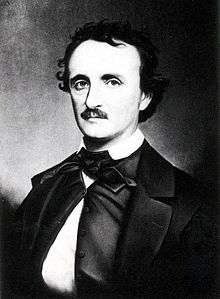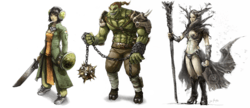Dark romanticism
Dark Romanticism is a literary subgenre of Romanticism, reflecting popular fascination with the irrational, the demonic and the grotesque. Often conflated with Gothicism, it has shadowed the euphoric Romantic movement ever since its 18th-century beginnings. Edgar Allan Poe is often celebrated as one of the supreme exponents of the tradition.

| Fantasy |
|---|
 |
| Media |
|
| Genre studies |
| Subgenres |
|
| Fandom |
| Categories |
|
|
Definitions
Romanticism's celebration of euphoria and sublimity has always been dogged by an equally intense fascination with melancholia, insanity, crime and shady atmosphere; with the options of ghosts and ghouls, the grotesque, and the irrational. The name "Dark Romanticism" was given to this form by the literary theorist Mario Praz in his lengthy study of the genre published in 1930, ‘’The Romantic Agony’’.[1][2]
According to the critic G. R. Thompson, "the Dark Romantics adapted images of anthropomorphized evil in the form of Satan, devils, ghosts, werewolves, vampires, and ghouls" as emblematic of human nature.[3] Thompson sums up the characteristics of the subgenre, writing:
Fallen man's inability fully to comprehend haunting reminders of another, supernatural realm that yet seemed not to exist, the constant perplexity of inexplicable and vastly metaphysical phenomena, a propensity for seemingly perverse or evil moral choices that had no firm or fixed measure or rule, and a sense of nameless guilt combined with a suspicion the external world was a delusive projection of the mind—these were major elements in the vision of man the Dark Romantics opposed to the mainstream of Romantic thought.[4]
18th- and 19th-century movements in different national literatures
Elements of dark romanticism were a perennial possibility within the broader international movement of Romanticism, in both literature and art.[5]
Dark Romanticism arguably began in Germany, with writers such as E. T. A. Hoffmann,[6] Christian Heinrich Spiess, and Ludwig Tieck – though their emphasis on existential alienation, the demonic in sex, and the uncanny,[7] was offset at the same time by the more homely cult of Biedermeier.[8]
British authors such as Lord Byron, Samuel Taylor Coleridge, Mary Shelley, and John William Polidori, who are frequently linked to Gothic fiction, are also sometimes referred to as Dark Romantics.[9] Dark Romanticism is characterized by stories of personal torment, social outcasts, and usually offers commentary on whether the nature of man will save or destroy him. Some Victorian authors of English horror fiction, such as Bram Stoker and Daphne du Maurier, follow in this lineage.
The American form of this sensibility centered on the writers Edgar Allan Poe, Nathaniel Hawthorne, and Herman Melville.[10] As opposed to the perfectionist beliefs of Transcendentalism, these darker contemporaries emphasized human fallibility and proneness to sin and self-destruction, as well as the difficulties inherent in attempts at social reform.[11]
French authors such as Jules Barbey d’Aurevilly, Charles Baudelaire, Paul Verlaine and Arthur Rimbaud echoed the dark themes found in the German and English literature. Baudelaire was one of the first French writers to admire Edgar Allan Poe, but this admiration or even adulation of Poe became widespread in French literary circles in the late 19th century.
20th-century influence
Twentieth-century existential novels have also been linked to Dark Romanticism,[12] as too have the sword and sorcery novels of Robert E. Howard.[13]
Criticism
Northrop Frye pointed to the dangers of the demonic myth making of the dark side of romanticism as seeming "to provide all the disadvantages of superstition with none of the advantages of religion".[14]
See also
References
- First English translation 1933. The title in its original Italian is: "Carne, la morte e il diavolo nella letteratura romantica" (Flesh, death, and the devil in romantic literature".
- Dark Romanticism: The Ultimate Contradiction Archived 2007-01-28 at the Wayback Machine
- Thompson, G. R., ed. "Introduction: Romanticism and the Gothic Tradition." Gothic Imagination: Essays in Dark Romanticism. Pullman, WA: Washington State University Press, 1974: p. 6.
- Thompson, G.R., ed. 1974: p. 5.
- Roland Borgards; Ingo Borges; Dorothee Gerkens; Claudia Dillmann (2012). Dark Romanticism: From Goya to Max Ernst. Distributed Art Pub Incorporated. ISBN 978-3-7757-3373-1.
- A. Cusak/B. Murnane, Popular Revenants (2012) p. 19
- S. Freud, 'The Uncanny' Imago (1919) p. 19-60
- Stephen Prickett; Simon Haines (2010). European Romanticism: A Reader. Bloomsbury Academic. p. 32. ISBN 978-1-4411-1764-9.
- University of Delaware: Dark Romanticism
- Robin Peel (2005). Apart from Modernism: Edith Wharton, Politics, and Fiction Before World War I. Fairleigh Dickinson Univ Press. p. 136. ISBN 978-0-8386-4079-1.
- T. Nitscke, Edgar Alan Poe's short story "The Tell-Tale Heart" (2012) p. 5–7
- R. Kopley, Poe's Pym (1992) p. 141
- Don Herron (1984). The Dark Barbarian: The Writings of Robert E Howard, a Critical Anthology. Wildside Press LLC. p. 57. ISBN 978-1-58715-203-0.
- Northrop Frye, Anatomy of Criticism (1973) p. 157
Further reading
- Galens, David, ed. (2002) Literary Movements for Students Vol. 1.
- Harry Levin, The Power of Blackness (1958)
- Mario Praz The Romantic Agony (1933)
- Mullane, Janet and Robert T. Wilson, eds. (1989) Nineteenth Century Literature Criticism Vols. 1, 16, 24.